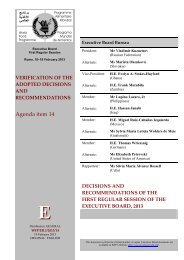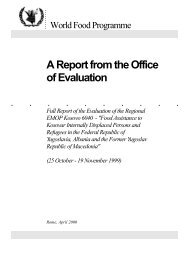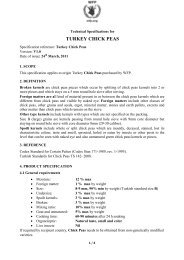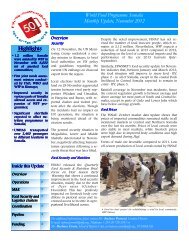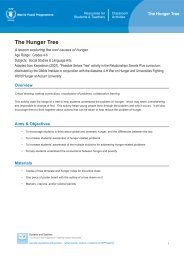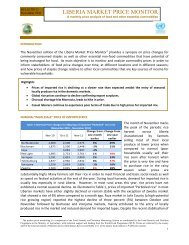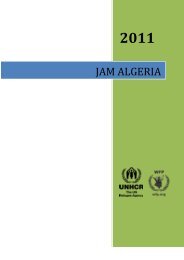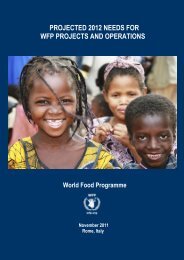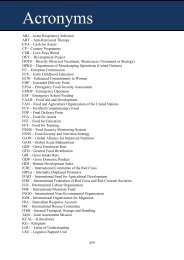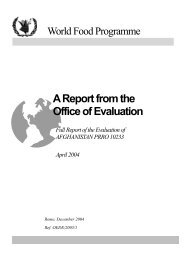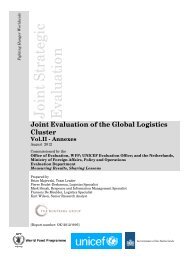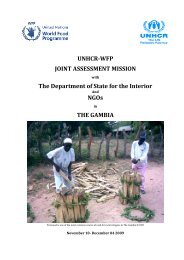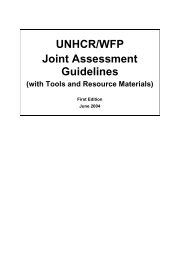The Potential for Scale and Sustainability in Weather Index Insurance
The Potential for Scale and Sustainability in Weather Index Insurance
The Potential for Scale and Sustainability in Weather Index Insurance
You also want an ePaper? Increase the reach of your titles
YUMPU automatically turns print PDFs into web optimized ePapers that Google loves.
THE POTENTIAL FOR SCALE AND SUSTAINABILITY IN WEATHER INDEX INSURANCE<br />
FOR AGRICULTURE AND RURAL LIVELIHOODS<br />
Chapter 3<br />
Key drivers of susta<strong>in</strong>ability<br />
<strong>and</strong> scalability of weather<br />
<strong>in</strong>dex <strong>in</strong>surance<br />
In the past, crop <strong>in</strong>surance programmes have per<strong>for</strong>med poorly, present<strong>in</strong>g numerous<br />
logistical <strong>and</strong> adm<strong>in</strong>istrative challenges <strong>and</strong> lack<strong>in</strong>g susta<strong>in</strong>ability. But new <strong>in</strong>terest <strong>in</strong><br />
market-mediated approaches to risk management, along with new opportunities <strong>for</strong><br />
<strong>in</strong>surers to pool covariate risks <strong>in</strong> <strong>in</strong>ternational f<strong>in</strong>ancial markets, make <strong>in</strong>dex<br />
<strong>in</strong>surance appeal<strong>in</strong>g. In addition, grow<strong>in</strong>g concern <strong>for</strong> the need to adapt to climate<br />
change is emerg<strong>in</strong>g as an important driver of weather <strong>in</strong>surance. As a result, numerous<br />
pilot programmes have been launched <strong>in</strong> recent years, with the active engagement of a<br />
diverse range of actors (<strong>in</strong>clud<strong>in</strong>g governments, donors, multilateral agencies,<br />
<strong>in</strong>ternational re<strong>in</strong>surers, relief agencies, NGOs, private <strong>in</strong>surers, banks, <strong>in</strong>put suppliers,<br />
food market<strong>in</strong>g companies <strong>and</strong> farmers’ organizations). Table 3 provides the details of<br />
36 such ventures, <strong>in</strong>clud<strong>in</strong>g six disaster-relief <strong>in</strong>surance programmes <strong>in</strong> 21 countries<br />
<strong>and</strong> 30 agricultural development <strong>in</strong>dex <strong>in</strong>surance programmes <strong>in</strong> 19 countries.<br />
<strong>The</strong> table highlights the diversity of the <strong>in</strong>dex <strong>in</strong>surance world. Development<br />
<strong>in</strong>surance programmes range from privately provided <strong>and</strong> unsubsidized schemes –<br />
l<strong>in</strong>ked to comprehensive packages of agricultural development <strong>in</strong><strong>for</strong>mation <strong>and</strong><br />
services <strong>for</strong> farmers – to publicly provided, heavily subsidized schemes with weak or<br />
no value propositions. An example of the <strong>for</strong>mer is the PepsiCo potato out-grower<br />
programme (see Case Study 2), while <strong>for</strong> the latter, the Agriculture <strong>Insurance</strong> Company<br />
of India (AIC) offers area-yield <strong>and</strong> drought <strong>in</strong>surance on a heavily subsidized basis to<br />
all takers (Case Study 5). Disaster relief programmes vary from <strong>in</strong>ternational <strong>in</strong>surance<br />
arrangements that directly underwrite government relief costs to programmes run by<br />
NGOs that provide disaster relief <strong>in</strong>surance directly to communities or farmers (see<br />
Case Study 3: Ethiopia). <strong>The</strong>y also vary with the type of <strong>in</strong>dex used. While most<br />
programmes use weather <strong>in</strong>dices, others use <strong>in</strong>dices based on crop-cutt<strong>in</strong>g (i.e. harvest)<br />
estimates of area yields (e.g. AIC <strong>in</strong> India, see Case Study 5), county-level livestock<br />
mortality rates (e.g. Mongolia) <strong>and</strong> biophysical model estimates of range productivity<br />
(e.g. Canada <strong>and</strong> the United States, see Case Studies 6 <strong>and</strong> 7).<br />
Most of the programmes are still young <strong>and</strong> have yet to reach large numbers of<br />
beneficiaries. Among the agricultural development programmes, India has achieved<br />
the greatest success, with a number of private weather <strong>in</strong>surance schemes that together<br />
33



